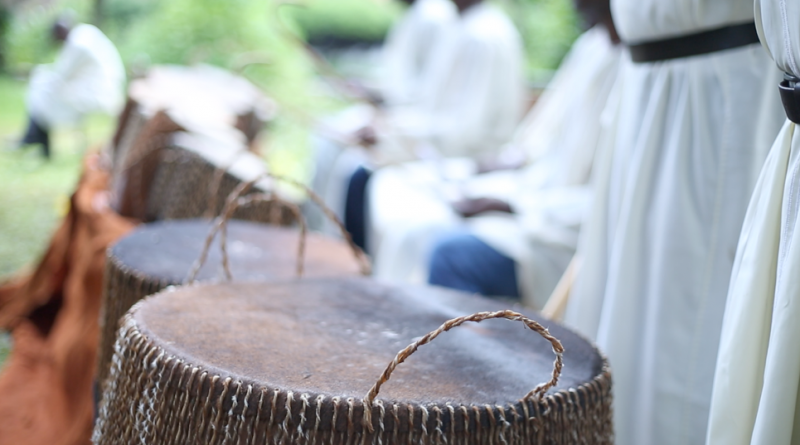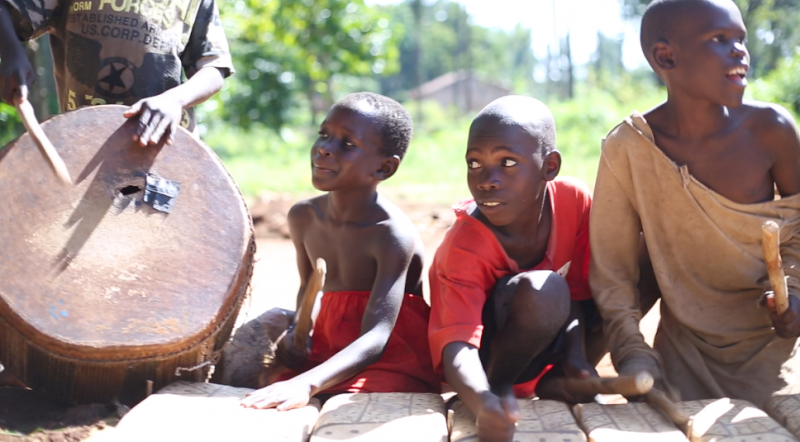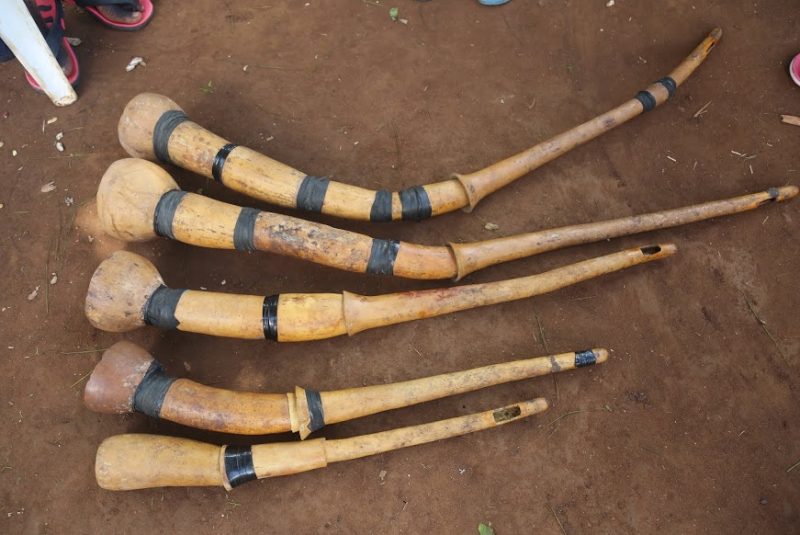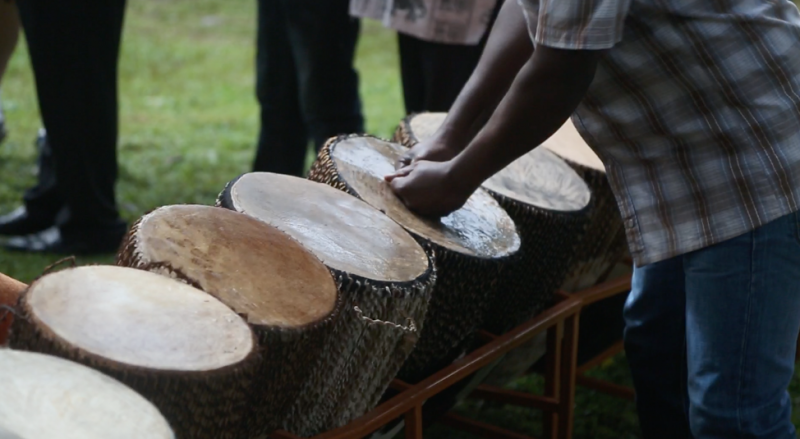December 3rd: reflections at the Kampala museum
This is our final day in the field in Uganda. Tomorrow we head back to Nairobi to record in the Ketebul Studios: we identified a whole set of extraordinary musicians from our 2013 visit to Uganda and have invited them back to do studio recordings. But today, we focused on two things:
1) Discussing in detail some of our observations from our time exploring the royal instruments of the kingdoms of Uganda
2) Recording again Albert Ssempeke’s Buganda Music Ensemble. Given that we first decided to rediscover the Royal Drums after recording Albert’s group in 2013, we wanted to end this field visit with his recordings

Part one: reflections
We are sitting on the grounds of the Kampala Museum, surrounded by examples of grass huts from the various regions of Uganda. These are empty, display houses, not homes – put up to give visitors a sense of a rapidly dying village culture. They are beautiful because they reflect the organic simplicity and lovely practicality of village life. They are disturbing because they are empty, rebuilt only for display and in their sterility, they look more like fossils than homes.
These are the images that inform our discussions. What does it mean to preserve or to rediscover cultural elements? What part of our efforts should focus on preserving music, like these grass huts, before it dies? What part of our efforts should focus on reviving the music, using it to inspire new generations to build on it in their own way, as thousands of generations did before? This has always been the core tension of Singing Wells. We have always had two missions. First, and sadly, we must preserve elements of a dying culture. And sadly, we have dozens of the only or last great village performances of musicians who have died after our visit. This mission is sad, but vital. At least future generations have these recordings and when/if they seek to understand something unique about their heritage, our recordings will be there for reference. But we have always wanted to do more than this – we want to find great musicians and help their music to reach new audiences. That is why we will be in Nairobi in the studios with musicians from our 2013 visit to Uganda – we are recording them professionally, surrounding them with great new artists and we hope giving them an opportunity to find new listeners that want to take elements of the music forward.

With this as background, this is what we discussed on the grounds of the Kampala Museum. I will paraphrase a half a dozen voices and many long and winding conversations:
What is it we’re reviving: palace life or music?
We can be emphatic here. We are here for the music and are neither romanticising nor trying to revive palace life.
We have allowed the former palace musicians to give their reflections on their lives, but let us now provide our observations on ‘palace life.’ The kings played a vital role as patrons of a rich and vibrant musical heritage. They not only supported the musicians who made it to the palaces, but also a vast ecosystem of villages that focused on instrument making or villages that focused on training potential musicians for the palaces. This patronage was not free, however, and the resources to fund the palaces and their music ultimately came from the same villages, through taxation and food contributions.
Moreover, these musicians were not empowered to create, to lead rich musical lives, to become artists, to use the palace as a stepping stone to develop their art further. They were brought into these palaces as young boys, and all they did was play music. In most cases they received no other education and in most cases they played until they could play no more and their ‘retirement pension’ was the salaries of the sons or grandsons they were able to train and bring into the palaces. Their musical lives were very ritualistic, playing at specific times, for specific ceremonies that provided the soundtrack to palace life. They were not writing songs to reflect their own trials and tribulations, nor were they voices for their generation. We must not romanticise what some might call musical servitude or slavery.
And this is why when the kingdoms fell these musicians faced such a total collapse. They had no education other than the one instrument. They had not learned to fend for themselves – the palace took care of all their needs. The impact was not just personal – it impacted their fathers and grandfathers, their children and grandchildren, and often everyone in their village. There was no other audience for their music – the palace was the market. And many musicians ended up in abject poverty, victims of a complete spiritual collapse.
So, no, we don’t want to restore palace life. But, we are here for the music – and some of this music is stunning. You have songs and styles perfected over generations. You have rich, complex layers of music, mostly built around the pentatonic scale. You have songs of a single instrument written for five or six different musicians – the Royal Drums, the xylophone, the flutes, the trumpets all follow this pattern and there are magical moments that happen in such complex song-writing.
Are all instruments the same?
Here we are less sure. The xylophone is extraordinary and continues to thrive outside of palace life. Xylophones didn’t disappear in Uganda village life after the fall of the kingdoms in 1966 because they were part of village life. We don’t need to rediscover the xylophone and we are fairly sure it is not on the endangered list. Contemporary Ugandan musicians are incorporating the xylophone into contemporary songs. We do need to record the best village players and make sure others can find them, but there is probably a ‘market.’

Bigwala trumpets
At the other extreme, the Bigwala horns of the Busoga kingdom or the trumpets of the Buganda kingdom are unlikely to enter the musical mainstream. They are ceremonial instruments and in some sense need a king – they were used to announce the King’s entrance and exit, or to ‘proclaim’ something, much like the trumpets of English kings. It is vital that they not be lost and we have actively support the restoration of the Bigwala – and through this project have discovered the Bigwala Model (more on this in a moment). But it is not clear that a contemporary musician will incorporate these instruments into their music – they might be ‘of a time’, and ‘need a king or two.’

Entenga drums
And this brings us to the Entenga, the Royal Drums of the Buganda Kingdom. While drums thrive in Uganda, these drums were lost. If drums are thriving, what is the point of focusing on the Entenga? We come away from this trip giving three reasons:
- They are on the endangered list. 15 drums and six musicians is a big expensive ensemble and most villages will have never heard these drums or their performances. Without intervention, they will die.
- They are unique and extraordinary: if you lose these drums, you lose the peak of Ugandan drumming. No one else is performing the complex tapestries of the Entenga drums, which mirror the xylophones, which are written for six musicians, each with their own parts, playing melody and bass lines, and harmonizing across both. You will not hear this richness in any current drums.
- They are exciting, vibrant, modern and relevant: we all walked away in love with these drums and we are only at the first stage. These are new drums that don’t yet have the rich tones of drums that have been ‘played in’. And these are musicians who are only two months in to a lifetime journey to learn the music. And yet, we all walked away convinced that you will see an exciting new East African artist writing new amazing music with these drums as part of the rhythm section.
Are there lessons from this journey?
Yes, and the most important of these is our discovery of a single repeatable model to restore these instruments: we refer to this as the Bigwala Model. What James Isabirye discovered from his work to restore the Bigwala trumpets is a five step model that we have now used for the Entenga drums and the Buganda flutes. These steps are:
- Step 1: Find ‘the professor’: James did this with the Bigwala with the discovery of James Lugolole, whom we met in Bukakaire. And he did it again with Musisi and the drums and with Richard Sewanyana and the Buganda flutes.
- Step 2: Find the students: James did this with the Bigwala with James Mukama, who was James Lugolole’s student. Musisi had Shaban. And Richard has taught Albert, Shaban and his group.
- Step 3: Find money to build the infrastructure. We can’t hide from this. A Unesco grant kick-started the Bigwala project. Singing Wells kick-started the Entenga project. But these projects won’t happen without ‘kick-starting’ and then sustainable funding. We have to ask ourselves: where is the support of the royal kingdoms or their people? We can only show them what they are missing – but the local communities must decide if and how to support this music on a sustainable basis.
- Step 4: if there is support, build the infrastructure. This involves seeds for gourds for trumpets, or drum-making for drums. Inevitably something needs to be invested in the infrastructure.
- Step 5: Bring on the young. Inevitably, you then need to bring on the people to learn and enjoy this music. And here we had an interesting debate. Some of our palace musicians felt the young people didn’t care anymore. But it was Ben Nsumugo Ntabula who provided a wonderful concluding observation: “Every time we set up our instruments and play, the children come and the children dance and the children ask us to stay. We can’t say they’ve lost interest. All we can say is that they’ve lost access to the music.”
In the fields of the Kampala museum we debated all this through blazing suns and pending thunderstorms. And we agreed to meet in Nairobi over the weekend to reflect further and decide the next steps for Singing Wells. Enough chatter, we concluded, let’s get back to the music.
